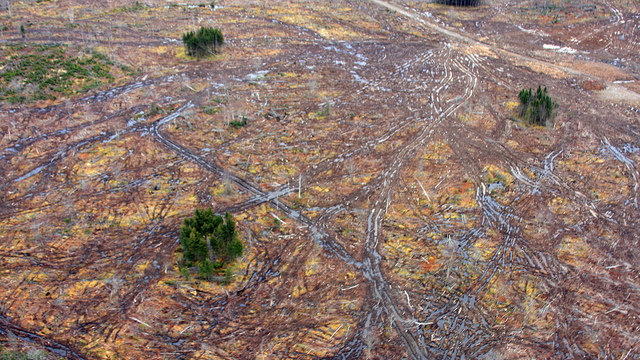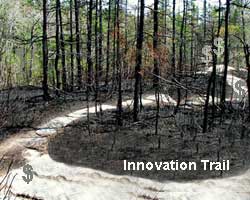Use of genuine by-products from sawmills to produce heat and electricity, biofuels and the like could reduce carbon emissions compared to use of coal or other petroleum products. However, that’s a slippery slope as we have seen in the case of our larger biomass energy plants which take in primary forest biomass when there are not enough wastes, or just because it’s cheaper.
View also the submenus under this heading – Literature, Accounting Standards & Data, Using The Feds’ Bioenergy GHG Calculator, Wastes and Residues, Business/Development, GHGs In the News (all in the ‘workin on it’ stage), also, items under REDUCING GHG EMISSIONS//INCREASING CARBON SQUESTRATION on the Climate Change page.
 Using primary forest biomass to produce bioenergy/biofuels increases GHG emissions over the next 50+ years compared to use of coal and other petroleum fuels. It’s over the next 50 yeas that we really need to reduce our GHG emissions. View:
Using primary forest biomass to produce bioenergy/biofuels increases GHG emissions over the next 50+ years compared to use of coal and other petroleum fuels. It’s over the next 50 yeas that we really need to reduce our GHG emissions. View:
– Natural Resources Canada GHG Calculator confirms Nova Scotia forest bioenergy schemes are worse than coal (Post on this website Jan 3, 2017)
– Biofuels increase, rather than decrease, heat-trapping carbon dioxide emissions (University of Michigan, 2016). “The study, based on U.S. Department of Agriculture crop-production data, shows that during the period when U.S. biofuel production rapidly ramped up, the increased carbon dioxide uptake by the crops was only enough to offset 37 percent of the CO2 emissions due to biofuel combustion. The researchers conclude that rising biofuel use has been associated with a net increase—rather than a net decrease, as many have claimed—in the carbon dioxide emissions that cause global warming. The findings were published online Aug. 25 in the journal Climatic Change… “This is the first study to carefully examine the carbon on farmland when biofuels are grown, instead of just making assumptions about it..”
It's TOO Big – Biomass from Peter Murphy on Vimeo.
More…
Forest Biomass Energy Policy in the Maritime Provinces: Accounting for Science
East Coast Environmental Law Report by Jamie Simpson, Dec. 2015. “We evaluate whether government policy on forest biomass in the Maritimes is keeping pace with science. Is the harvest of forest biomass sustainable from a biodiversity perspective and does the burning of forest biomass reduce overall carbon emissions? If not, then should governments continue to offer incentives to make forest biomass energy economically feasible?”
Are biofuels from Nova Scotia forests good for the environment? Show us the science!
Post on this website, May 4, 2017
 Stop destroying Nova Scotia’s forests for biomass power generation
Stop destroying Nova Scotia’s forests for biomass power generation
Started by a St. Margaret’s Bay resident in March 2016, this electronic petition garnered more than 25000 signatures in less than 10 days. Likely as a result, the province amended renewable electricity regulations, eliminating the “must run” designation for the Port Hawkesbury biomass plant. (View CBC news item.) As well, it led to the creation of the Nova Scotia Healthy Forest Coalition. The petition remains open. A paper petition for submission to the Nova Scotia legislature is now in circulation.
Healthy Forests Coalition Biomass Briefing Notes
Key issues are identified by the Healthy Forests Coalition.

“If we can’t burn it, we’ll find another way to use it. After all, we pay next to nothing for it.”
First steps on a crooked path
Short Update on Biomass, July 20, 2016. “On April 8, 2016, the NS Government announced that the Nova Scotia Power biomass plant will no longer run 24/7, which the Ecology Action Centre and others called ‘a great first step’ to eliminating biomass”… However, it wasn’t long before alternative uses of the “low grade” wood were being promoted such as marine biofuels…”
Feeding the Fire Biomass and Nova Scotia’s Race for the Bottom
Article by Linda Pannozzo in the Halifax Examiner, March 4, 2016. She explains why “calling biomass “renewable” in Nova Scotia is about as inconsistent as giving up liberty for freedom. It’s basically a lie and in the context of how forestry is done in this province it’s about as Orwellian as you can get.”
Oh Dear, “Europe Aims to Close Loophole on Wood Energy”
Post on this website.
The Great Carbon Scam
Article in new Scientist 21 Sep 2016. You may have to take out a free membership to view the article. It describes why biomass burned to produce electricity should not be counted as renewable energy.
It’s too big – The Biomass Plant at Port Hastings
By Robert Devet in The Nova Scotia Advocate. March 12, 2016. “In a mere 10 minutes this documentary makes the case that to feed the boiler, to satisfy the voracious appetite of the Point Tupper biomass plant, the Department of Natural Resources is stressing forests in eastern Nova Scotia and jeopardizing the future of much of the forest industry.”
Is wood a green source of energy? Scientists are divided
By Warren Cornwall in Science Jan. 5, 2017. A good overview of the debate on this topic in scientific & industrial circles. “This past February, 65 scientists, many from major universities, penned a letter to Senate leaders warning that the carbon-neutral label would encourage deforestation and drive up greenhouse gas emissions. But a month later, more than 100 scientists took the opposite view in a letter to EPA, stating that “the carbon benefits of sustainable forest biomass energy are well established.” A lot depends on whether you look at the next 40 or the next 100 years, also whether enhanced soil GHG emission following clearcutting are taken into account. The Planet will be an impartial judge.

Curved arrows represent biologically mediated flows of GHGs: the straight arrow, industrial emissions of GHGs; and the symbols at bottom right, long term sequestration of carbon in the oceans. Carbon dioxide is the most important GHG in relation to forestry.
Nova Scotia forests, forestry and GHGs 1: Letters
Post March 25, 2018. “Serious, thoughtful questions asked about the science behind our strategies to reduce GHGs are met with all-is-ok/trust-us replies”
Nova Scotia forests, forestry and GHGs 2: Who accounts for the EU’s emissions from bioenergy generated from imported chips?
Post July 27, 2018. “For chips from Canada, we do. Sort of. By not specifically addressing Land Use Changes associated with forest bioenergy in GHG accounting, industry and government avoid admitting that many of these schemes are net emitters of GHGs over timeframes meaningful for climate mitigation. There are signs, however, that the Europeans are recognizing serious problems with forest bioenergy sourced from North America.”
Time for Nova Scotia Government to come clean on forest bioenergy feedstocks 19Mar2019
Post, Mar 19, 2019.”The film Burned that is making the rounds in NS and elsewhere is NOT about forest bioenergy facilities for which most of the feedstocks are genuine wood processing wastes. It’s about forest bioenergy facilities for which most of the feedstocks are from clearcuts and are wreaking havoc upon forest biodiversity and forests’ storage of carbon. What’s the case in Nova Scotia?”
Are Protected Areas an Effective Way to Help Mitigate Climate Change? A Comparative Carbon Sequestration Model for Protected Areas and Forestry Management in Nova Scotia, Canada
Robert Cameron and Peter Bush 2016. The International Journal of Interdisciplinary Environmental Studies 11: 1-13.
View related post (May 26, 2017): Protected Areas in Nova Scotia help to mitigate climate change, clearcuts do not
NEW BIOMASS PLANT OPENS IN PORT HAWKESBURY
NSP Press release OCTOBER 30, 2013. Includes Interesting facts about the Plant (PDF)
-Online in July 2013 and supplying as much as 4% of the province’s total electricity requirement.
-At 60 MW capacity, the plant has the ability to power 50,000 homes.
-Its 150 metric tonne steam turbine (ST) was manufactured by Mitsubishi Heavy Industries (MHI) in Yokohama.
-The ST was being constructed when Japan suffered the Fukushima earthquake and tsunami resulting in the loss of electric capacity in the Tokyo region. MHI modified its manufacturing effort to absorb the disruptions and meet their commitment to NS Power to deliver the equipment by the end of April 2012.
-The Generator was shipped from Liverpool, England to arrive in Halifax concurrent with the ST.
-In April, a special train including a 12 axle rail car brought from San Diego was used to move the equipment from Halifax.
-The temperature of the steam when it leaves the plant boiler is 480 degrees Celsius.
-More than 75 different contractors worked on site during the construction of the plant.
-As many as 50 trucks a day deliver up to 2000 tonnes of biomass every day.
-It took 500,000 hours to construct the new biomass facility. The entire project timeline was completed without a lost time injury.Media Contact: Neera Ritcey, Nova Scotia Power 902-223-2272 (Cell) Neera.Ritcey@nspower.ca
A SOLID WOOD BIOHEAT GUIDE FOR RURAL COMMUNITIES IN ONTARIO
FPInnovations, Feb. 2020. From the Flyer: “What is the guide and why is it needed? With increasing heating costs and climate change becoming top of mind, communities are taking a more serious look at energy alternatives. One of the top choices for energy alternatives is bioheat from modern wood heating technology. Bioheat systems are reliable, efficient and can supplement or replace current fossil fuel and/or electric
heating systems with local, sustainably sourced, and renewable solid woody biofuels…The guide discusses only solid woody biofuel produced from forest resources. It refers to four categories of solid woody biofuel which are cordwood (firewood), wood
chips , wood briquettes, and wood pellets.
Partnership for Policy Integrity” Resources
“PFPI was founded in 2010 to provide a “one-stop shop” for all things biomass power related. While our mission is expanding, our resources page is still focused on providing resources for activists and citizen scientists who want to weigh in on bioenergy policy and projects. Here we provide links to data resources, key studies, examples of comment letters on federal and state rules, and examples of comment letters on biomass air permits. We can provide further resources and assistance (including reprints of linked articles) upon request.”
